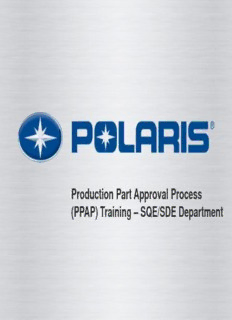
Production Part Approval Process (PPAP) PDF
Preview Production Part Approval Process (PPAP)
Production Part Approval Process (PPAP) Training – SQE/SDE Department Agenda Learning Objectives Purpose Table of Contents Overview PPAP Overview / Expectations References / Resources Learning Objectives Recap Wrap Up (FAQ / Q&A / Feedback) Learning Objectives At the end of this training, participants will be able to: • What is the Purpose of PPAP? • When is PPAP Required? • What are the Elements of the submission? • How are the Levels of PPAP applied? • Details on successful PPAP submission to Polaris’ facilities 3 Document Purpose • The sole purpose of this document is to provide additional information, training and guidance to Polaris’ supply base to ensure all PPAP documentation is provided in a manner consistent with expectations. • This document is not intended to be all encompassing. PPAPs are to be created and submitted on the basis of AIAG standards. Additional resources: • Automotive Industry Action Group (AIAG) 26200 Lahser Road, Suite 200 Southfield, MI 48034 Phone 248-358-3570 www.aiag.org Training options available: • Courses at AIAG’s headquarters in Southfield, MI • Onsite training • Webcasts • Quality-One Detroit, MI USA 1333 Anderson Road Clawson, Michigan 48017 Phone: 248-280-4800 Online training courses available for purchase at http://quality-one.com/online-training/ • Production Part Approval Process (PPAP) • Process and Design Failure Mode and Effects Analysis (PFMEA & DFMEA) • Measurement System Analysis (MSA) • Eight Disciplines of Problem Solving (8D) • Advanced Product Quality Planning (APQP) • Six Sigma Black, Green, White and Yellow Belt training • It is the supplier’s responsibility to reach out to a Polaris representative if there are questions or concerns regarding PPAP preparation/submission. If you are unsure of anything, please ask. 4 Table of Contents PPAP Overview Slide 6 18 Elements of PPAP Slide 13 Submission Requirements Slide 14 Submission Status Slide 16 Element 1 - Design Record Slide 17 Element 2 - Authorized Engineering Change Documents Slide 21 Element 3 - Customer Engineering Approval Slide 23 Elements 4 & 6 - Design and Process FMEAs Slide 24 Element 5 - Process Flow Diagram Slide 32 Element 7 - Control Plan Slide 38 Element 8 - Measurement Systems Analysis Studies Slide 46 Element 9 - Dimensional Results Slide 50 Element 10 - Records of Material/Performance Test Results Slide 54 Element 11 - Initial Process Studies Slide 56 Element 12 - Qualified Laboratory Documentation Slide 64 Element 13 - Appearance Approval Report Slide 66 Element 14 - Sample Production Parts Slide 70 Element 15 - Master Sample Slide 73 Element 16 - Checking Aids Slide 77 Element 17 - Customer-Specific Requirements Slide 79 Element 18 - Part Submission Warrant Slide 80 Note: Hyperlinks only work in presentation mode 5 What is PPAP? Production Part Approval Process – Rigorous and structured process for part qualification used to formally reduce risks prior to product or service release, in a team oriented manner using well established tools and techniques. – Initially developed by AIAG (Auto Industry Action Group) in 1993 with input from the Big 3 - Ford, Chrysler, and GM. – All AIAG forms are acceptable Contact AIAG At: Automotive Industry Action Group 26200 Lahser Road, Suite 200 Southfield, MI 48034 Phone 248-358-3570 www.aiag.org 6 Purpose of PPAP • Provide evidence that all customer engineering design records and specification requirements are properly understood by the organization and achievable. • To demonstrate that the manufacturing process has the potential to produce product that consistently meets all requirements during an actual production run, at the quoted production rate. • All PPAP submission data/documentation shall be based on a significant production run as defined as any time period/quantity used to establish process capability, with all normal process variation accounted for. PPAP manages change and ensures product conformance! 7 When is PPAP Required? • PPAP submission required when: – New part released for production – Engineering change order (ECO) – Correction from previous submission discrepancy – Process Change Request (PCR) – any change to product or process. Note: Reference the Polaris PCR Training Guide for further details / guidance. Some examples: – Alternative construction or materials – Tooling or equipment refurbishment, replacement, transfer or additional – Production at new or additional location – Change of or at a subcontractor or material source change – Product or process changes to component Note: At the discretion of Polaris, a PPAP submission may be requested at any time. PPAP is required for any new or changed part/process!! 8 Benefits of PPAP Submission • Forces formal part conformance and approval • Ensures formal quality planning • Helps to maintain design integrity • Identifies issues early for resolution • Reduces warranty charges and prevents costs of poor quality • Assists with managing supplier changes • Prevents use of unapproved and nonconforming parts • Identifies suppliers that need more development • Improves the overall quality of the product & customer satisfaction 9 Importance of Attention to Detail • In the last three months an analysis was completed on rejected PPAP submissions. • The majority of the rejected submissions were easily preventable (not filling out forms properly and/or not following simple directions/requirements). PQR Submittals • 62% Approved Documentation Missing or Discrepancy 27% • 38% Rejected • Majority due to documentation missing or discrepancy Approved 62% Dimensional Discrepancy 8% Inadequate Controls 3% ~ 70% of PPAP submission failures due to documentation 10
Description: